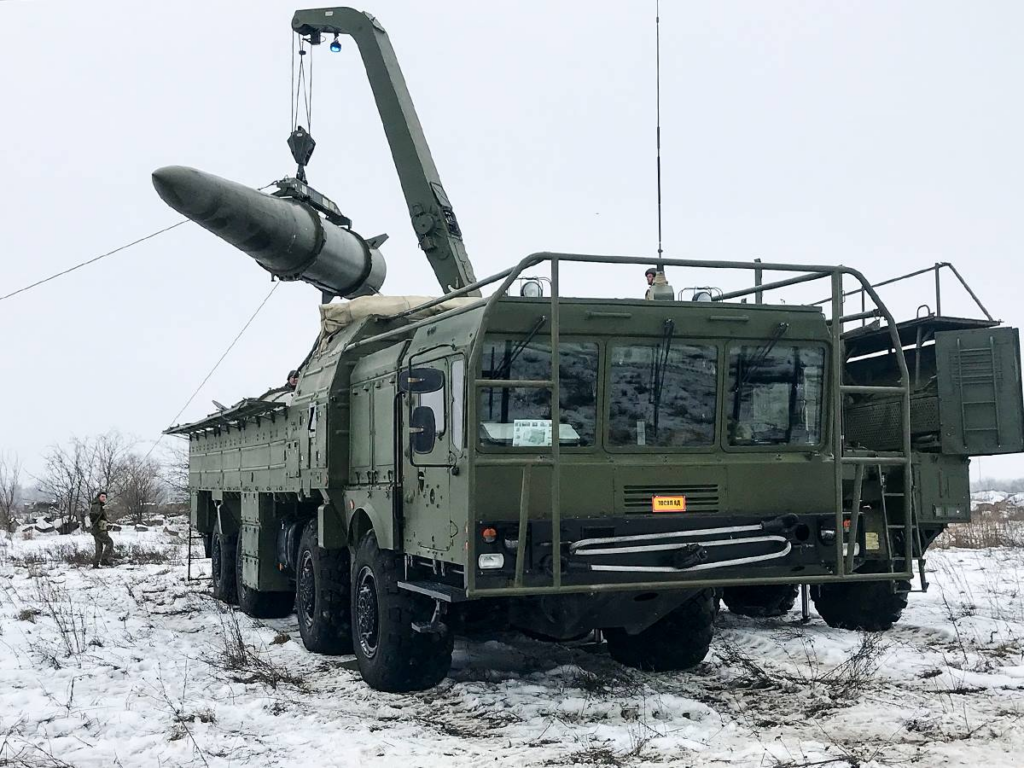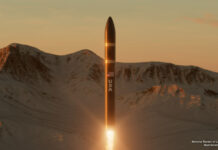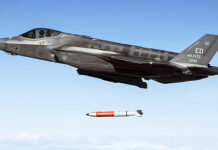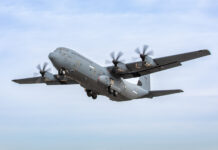While tactical ballistic missiles have been used on battlefields in previous conflicts, the war in Ukraine has seen some of the most intense usage of such systems in any modern conflict.
With some historical introductory anecdotes, this article looks at tactical missile use against Ukraine through the eyes of Ukrainian intelligence. It addresses developments in and around the Ukrainian theatre of operations, as well as mentioning one of the country’s own tactical missile systems, and a US system Ukraine would sorely like to have, but will likely remain at arms’ length, for now, at least.

Credit: US DoD
Historic Irony
The Russians have been launching a variety of tactical battlefield missiles with conventional warheads and cluster munitions against mainly civilian infrastructure in Ukraine since last year’s invasion. The threat to replace conventional warheads with tactical nuclear warheads on some of those missiles has also been made from the very start and continues to hang over the battlefield, particularly with the recent agreement between the Kremlin and Minsk to deploy tactical nuclear weapons to Belarus. For the Ukrainians, their limited number of home-grown tactical missiles have been no match for the large, though dwindling numbers, of Russian weapons and they remain hopeful – despite the arrival of air-launched Storm Shadow cruise missiles from the UK, with their operational range up to 550km – for a weapon system from the West’s ground-launched arsenal of longer range, tactical missile systems.
That such missiles might potentially face off against each other, depending on decisions taken later on, it might be interesting to take a brief, ironic look back to the end of WWII, when the Nazi Germany’s advanced science and rocket technology ended up in the hands of both the Americans and Western forces, as well as their Soviet allies. That technology had achieved its metaphorical apogee at the time through the creation of the V-2 (also known as ‘A-4’), the world’s first tactical ballistic missile (and indeed the first ballistic missile), prototyped in the summer of 1944 and first launched against British and Belgian cities from September of the same year with devastating effect. So dangerous was the system, with its 320 km range, that allied forces prioritised the capture of V-2 launch sites and production facilities. By the end of the war, US forces had secured much of Nazi Germany’s scientific brainpower in the form of Wernher von Braun and some 100 fellow rocket scientists, together with rocket assemblies sufficient to construct some 80 missiles, all of which – scientists and hardware alike – were shipped to the US. Meanwhile, Soviet forces secured V-2 manufacturing facilities and subsequently removed these from German soil to the Soviet Union, where they resumed production of the weapon system after the war.

Credit: DIU
Fast forward from those ironic, post-WWII, technological starting points/boosts for both sides’ tactical missile developments to today’s bloodied battlefields and urban centres of Ukraine. Russian tactical missiles and drones of one sort or another, such as Iskander-Ms, rain down on Ukrainian towns and cities, while Ukrainian forces respond in limited fashion with the likes of home-grown Grom-2s, though await further discussions/protracted decisions from their allies about other long-range tactical missiles from western arsenals, such as the Army Tactical Missile System (ATACMS), which, despite latest political hesitations, must surely come, in long, ‘over-due’ course.
Real-World Use and Dwindling Stocks
Russia has used its various tactical and cruise missiles during its attacks on Ukraine with great intensity, but according to Ukrainian intelligence sources, until recently, there were increasingly longer periods between missile-heavy attacks, with a greater diversity of airborne weaponry used in more recent strikes, such as drones. This is a possible indicator that Russia’s tactical ballistic missile inventories are feeling the strain.
In mid-March 2023, Andrii Yusov, a representative of Defence Intelligence of Ukraine (DIU), the main directorate of intelligence of the country’s Ministry of Defence, stated that since the invasion began, tactical missiles such as Iskander-Ms, (amongst other missiles such as Kalibr and Kinzhal cruise systems), have been used in great numbers, but these are weapons Russia cannot afford, cost-wise and quantity-wise, to keep using. As a result, they have for some time been using their stocks of outdated, less accurate missiles, alongside these. One such example is their S-300P systems, which, are being employed as surface-to-surface tactical systems, as well as being used in their intended surface-to-air role. Indeed, the S-300P has several versions with different technical capabilities and ranges, the maximum aerial engagement range of the 48N6P-01 missile being 200 km (though its maximum range against land targets would be higher), carrying a warhead weighing 143 kg.
The DIU’s Yusov said that accuracy was something the Russians did not particularly ‘strive for’ with their missile strikes, making any less-accurate legacy stock well-suited to questionable tactics and indiscriminate targeting. In many cases, he said that missing targets by as much as a kilometre appeared to be an acceptable norm for the Russians, hence the reason why not just intended energy infrastructure was being struck, but also civilian facilities such as residential high-rise buildings, schools, maternity homes and hospitals. With large stocks of S-300P family missiles, it is a likely this series of missiles will continue to be used as surrogate surface-to-surface missiles for the long-term. That said, where a previous ‘missile terror tactic’ strike ‘periodicity’ of about a week, i.e. the amount of time needed to prepare for the next missile strike, had been observed by the DIU, (possibly the result of depleted stockpiles of precision tactical missiles and wait times for new missiles), the large inventory of S-300P family missiles and the use of other systems alongside, may see the frequency of missile strikes increase once more.
Tactical Overreach… or Oversight?
In March 2023, with DIU statements trying their best to keep pace with latest missile attacks, and the fluid and changing operational conditions on the battlefield, DIU’s Yusov said that tactical missile strikes at that time had been undertaken using missiles that Russian industry had been able to manufacture during the month immediately prior to strikes against Ukraine’s power infrastructure on 9 March 2023. He said a deficit of high-precision missiles now existed in Russian stocks and some tactical system numbers were ‘critically low’, resulting in the growing time gap between such attacks at that time as the Russians failed to replenish stockpiles in sufficient quantities quickly enough.

Credit: DIU
While not dealing with cruise missiles per se, Yusov cited, as a known example, the Kalibr family of cruise missiles, which possess a maximum range of 1,500 km to around 2,600 km depending on variant. According to Yusov, the Russians had only 7% of the Kalibr cruise missiles they had at the beginning of the full-scale aggression remaining at that time and that even new missile production would be unable to make up such losses in the circumstances. In November 2022, the DIU estimated there to be only 120 Iskander-Ms left in Russia’s tactical missile arsenal and that it was monitoring Kremlin plans to acquire the approximately 700 km operational range, Fateh-110/Zolfaghar tactical ballistic missile from Iran. The DIU said at the time that arrangements had already been made for these plans to be undertaken, and expected them to be shipped by air to Crimea, or by sea to Russian ports on the Caspian Sea. Yusov also noted that Russia was trying to use all approaches to circumvent sanctions, particularly by smuggling, or using ‘grey’ schemes, to secure the necessary components for missile and weapon production (more of which, below).
In the meantime, Russia appears to have modified its approach in the use of tactical missiles, certainly with a necessary, less-frequent expenditure of their most expensive tactical systems. Making slower progress in the overall fight, the Russians seem to have realised they were using up their tactical missile inventory unsustainably quickly, though not before having reached a point of running very low, not only of high-precision systems such as Iskanders, but long-range strike missiles in general. While Russia still has thousands of missiles, such as the S-300P series, in its inventory, many more of them have been used than have been produced. The DIU estimates that ‘no more than 30–40 missiles’ can be produced a month by the Russians, and that the older, legacy missiles in service either do not reach their targets due to malfunction, or have limited effectiveness due to “poor destruction radius”.
Tactical Nukes and Sanction Dimensions
Staying with the DIU, at the start of the year, another of the department’s representatives, Vadym Skibitskyi, spoke of the nuclear threat posed by Russia’s tactical, (and strategic), nuclear missile arsenal. With Ukraine’s military intelligence resources constantly monitoring the movements of these assets, he said Ukraine’s intelligence services “know all the storage locations” as well as “the number and deployment of nuclear weapons carriers” at the tactical level. He added that movements of all launch vehicles were constantly monitored, together with the activities of the 12th Chief Directorate of the Russian Defence Ministry. Also known as the Nuclear Technical Service Directorate, this is Russia’s department responsible, amongst other things, for preparation and delivery of nuclear warheads to deployed assets from their secure storage locations. Skibitskyi said that the whole process was not a simple one, but that the DIU has experience monitoring and gathering intelligence about tactical and strategic nuclear forces from military exercises conducted since 2014 and earlier, ‘so it knows all the procedural issues involved’ in the deployment of Russian tactical nuclear missiles and other materiel.

Credit: DIU
Skibitskyi also commented at that time about sanctions, touched on earlier, and Russia’s changing missile tactics and capabilities, commenting that the impacts of economic sanctions on the Russian Federation were visible and their resulting efforts to circumvent sanctions and import components for missiles and other weaponry were monitored by the DIU. Information collected was shared with Ukraine’s partners, and ‘other measures’ were taken to prevent missile and weapon production by Russia from increasing. Skibitskyi said today’s Russian tactical missile deficit related particularly to Iskander tactical ballistic missiles, as well as air and sea-launched cruise missile systems, but that while the number of high-precision missile strikes and their density and intensity had lessened in recent months and weeks, it had to be recognised that the production of tactical missiles in Russia continued. “Unfortunately, production does not stop,” he said. “Their volume is not that big, but they are produced. We now find debris from missiles made in the fourth quarter of 2022. Therefore, they are produced and immediately given to the troops for the shelling of our facilities.”
Skibitskyi recalled that with dwindling missile stocks and this almost ‘just-in-time’ supply of new missiles, “the enemy began to combine and change tactics”. As alluded to earlier, this is apparent through the different weapon compositions of a strike, such as the inclusion of Iranian-made UAVs and Loitering Munitions (LMs), legacy tactical missiles, high-precision tactical ballistic missiles and modified S-300 SAM missiles employed in a surface-to-surface, tactical missile role, for their strikes, rather than just one missile system. DIU’s Yusov commented at that time that while Russia’s stockpile of certain high-precision missiles, like the Iskander-Ms, “has fallen to a critically low level” they still have a “sufficient number” of S-300 missiles, which they use to strike frontline cities and towns, such as Kharkiv, Kherson, Mykolaiv, Sumy and Zaporizhzhia.
UK MoD’s Long Range Strike
As tactical missiles and drones fly in Ukrainian skies, predominantly in one direction, the UK MoD, as part of its International Fund for Ukraine (IFU), has recently tendered for a ‘Long Range Strike’ capability. Expressions of interest (EOI) were requested for land, sea or air-launched missile or rocket systems with a range between 100–300 km, and a payload of between 20–490 kg. The tender, which closed on 4 May, posted ‘desirable requirements’ for the system to include:
- Low Probability of Intercept (LPI);
- A mission planning capability;
- Assured navigation (with hardened Global Navigation Satellite System capability) in the face of advanced countermeasures and EM spectrum denial;
- Air defence penetration methods to increase probability of successful strike;
- Technical Readiness Level of at least 8.
The IFU is a funding mechanism that uses funding from international partners to procure priority military assistance for Ukraine and is intended to ensure the continued supply of military support – lethal and non-lethal – through 2023 and beyond. The fund is administered by the UK MoD on behalf of an executive panel, comprising the UK, Norway, the Netherlands, Denmark and Sweden. These partners, along with Iceland and Lithuania, have contributed a collective total of more than GBP 520 M to the fund to date. Supplier EOIs for Long Range Strike are currently being assessed at time of writing and suppliers of interest are set to be contacted from 5 June 2023.
Ukraine’s Own and ATACMS Question
With Iskander-Ms having been used extensively, though now in short supply, Ukraine has been able to mount a limited response with its own home-grown Grom-2/HRIM system, which Russia claims to have had some success in shooting down. At the same time, Ukraine still hankers after the US ATACMS. These three systems are all tactical short-range ballistic missiles (SRBMs) with effective ranges out to approximately 500 km (300 miles). However, rather than giving further space to the Iskander-M, the focus here is on Ukraine’s own homegrown Grom-2/HRIM system, the US ATACMS. At the time of writing the US continues to hold the position that it has insufficient stockpiles of ATACMS to be able to supply this weapon system to Ukraine; whether that will change has yet to be seen. With this conflict’s history of delayed decisions in the supply of weapon systems…probably best to ‘never say never’.

Credit: VoidWanderer, via Wikimedia Commons
Ukraine’s home-grown short-range ballistic missile system developed by the Pivdenne Design Office and AM Makarov Southern Machine-Building Plant is referred to by various names, including the Operational-Tactical Missile System Hrim-2, also OTRK Sapsan, and, as referred to earlier, Grom-2. Similar in role and capabilities to the Iskander, Grom-2 was intended to replace Ukraine’s stock of 120 km range Tochka-U SRBMs, its predominant tactical missile of recent years. The single-stage Grom-2, is controlled using inertial navigation system (INS) and global navigation satellite system (GNSS) guidance and has been reported to possess a terminal homing capability, perhaps indicating the presence of a radar seeker. The export variant has been stated to have a range of 280 km to comply with the Missile Technology Control Regime (MTCR), but the domestic variant is reportedly capable of reaching out to around 500 km. The missile is armed with carrying a 480 kg warhead, comprising either a high explosive fragmentation (HE-FRAG) or penetrating HE-FRAG unitary warhead, or HE-FRAG submunition natures. Grom-2’s approximate area of effect with the unitary HE-FRAG warhead exceeds 10,000 m2, while the submunition warhead covers 30,000 m2. Two missiles can be carried on the Ukrainian-made, 10×10 wheeled transporter erector launcher (TEL) vehicle, which must elevate the missiles to a vertical firing position prior to launch.
The Grom-2 was reportedly used against the Saky Air Base in occupied Crimea in August 2022, with several explosions having occurred, although this remains unconfirmed by the Ukrainians. In May 2023, Russian media outlets and officials claimed that two Grom-2 tactical ballistic missiles had been shot down by air defences over Crimea, although, once again, this incident has not been verified by Ukraine.
Ukraine’s Missile Wish-List
Concurrently with the UK’s IFU tender, the UK has sent air-launched Storm Shadow long-range cruise missiles to Ukraine, which have, reportedly, already been in use. This may give the Americans some comfort in their decision to hold onto their ATACMS stock, claiming the US arsenal has insufficient numbers of these missiles to make such a move wise. So, while, for now, any temptation to supply Ukraine with Lockheed Martin’s ATACMS has been resisted, the missile, nevertheless, remains on Ukraine’s wish-list.

Credit: US Army
As for the ATACMS, the family is already long in the tooth, with the earliest missile variant first seeing use in Operation Desert Storm in 1991. During that conflict, according to US Government records, some 30 of these road-mobile, solid-propellant fuelled, surface-to-surface systems were used to strike Iraq’s medium-range ballistic missile launchers and surface-to-air missile sites at ranges of up to 160 km.
The MGM-140 ATACMS had effectively taken over from the MGM-52 nuclear-capable, Lance missile system in the 1980s and now has a successor lined up in the form of the Precision Strike Missile, or PrSM, which should enter service in 2023/2024. Whether growing stockpiles of the newer system make a difference to the ATACMS decision is a guessing game, but with no end to the war in Ukraine in sight, if the Ukrainians do eventually get their ATACMS wish, the capabilities it will afford them are many. According to manufacturer, Lockheed Martin, the guided missile is a conventional long-range, precision-strike, surface-to-surface artillery weapon system packaged in MLRS look-alike launch pods and launched from the MLRS family of launchers (the MLRS M270 and M270A1 platforms), as well as being M142 High Mobility Artillery Rocket System (HIMARS) compatible. Two missile pods can be carried by the MLRS vehicles and a single pod on HIMARS, with each pod containing one ATACMS missile. The system incorporates an improved guidance package with INS/GNSS, carries a unitary WDU-23/B, 227 kg (500 lb) blast fragmentation warhead, and has a maximum range of 300 km. FY20 contracts for MGM-140B ATACMS production totalled USD 426 M with over 400 missiles made during that period. As of 2020, eight nations have procured and fielded the system.

Credit: US Army
Beyond ATACMS…
As for its PrSM successor, this missile again is designed to be launched from the M270A2 MLRS vehicle and the M142 HIMARS. The baseline missile, ‘Increment 1’, will be developed and fielded to engage a wide variety of point and imprecisely located targets at ranges greater than 400 km. The PrSM will give field artillery units a long-range, deep-strike capability, at the same time supporting brigade, division, corps, army, theatre, joint/coalition forces, and marine air-ground task forces. In replacing ATACMS, it will double the volume of fire with two missiles per launch pod and will maintain and improve accuracy in partial GPS-degraded environments; the missile is slated for M-Code GPS integration to improve resistance to jamming.
Lockheed Martin successfully completed three prototype flight tests in late 2020 and is set to field its first production missiles by the end of 2023 under the terms of its Urgent Materiel Release (UMR) contract awarded by the US DoD at the end of 2021. While an initial competitor to Lockheed Martin in the programme, Raytheon withdrew from the Long-Range Manoeuvrable Fires programme in 2020 after difficulty with prototype flight tests, but has recently re-entered the fray following the award of a USD 97.7 M contract from the US Army. This is for design advancement for PrSM Increment 4, which aims at a system with considerably increased range, possibly out to 1,000 km. Raytheon is partnering with Northrop Grumman in this effort.
Tim Guest












